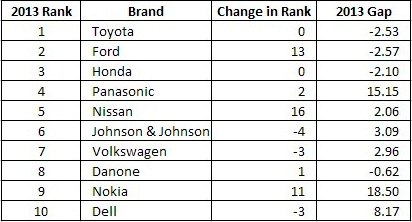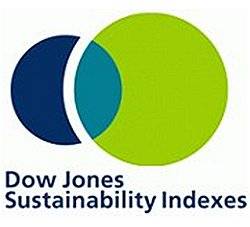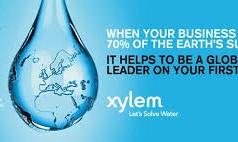Top Risers (by Rank): Nissan, Ford, UPS & Nokia
As referenced earlier, Nissan (#5), the Japanese automaker, emerged as the top riser on this year’s report. The brand moved up 16 places (from #21) and broke into the top 10.
In 2012, Ford (#2) moved sustainability from the periphery to the center of its business strategy. As a result, the American automaker moved up 13 spots to claim one of the top spots in this year’s report. Ford heavily promoted its EcoBoost engine in its best-selling F-150 pickup truck – a message that clearly resonated with consumers. (In 2012, Ford sold 334,364 EcoBoost-equipped vehicles, more than one-and-a-half times the number it sold in 2011.)
 Nokia (#9) and UPS (#32) both jumped 11 places. For nearly a decade, corporate responsibility has been a focal point at Nokia, the Finnish multinational technology corporation. As a result, Nokia holds prominent positions among several international sustainability rankings, including the Dow Jones Sustainability Index, Greenpeace Guide to Greener Electronics, and Forbes’ List of the World’s Most Sustainable Companies. Moving up 11 places, UPS, the multi-billion-dollar corporation that focuses on enabling commerce around the globe, continues to explore new ways in which its supreme knowledge of renewable energy and advanced fleet technology can be applied to every aspect of its business. UPS recently announced one of the largest single deployments of zero-emission vehicles in the world; a 100-strong fleet that will reduce consumption of conventional motor fuel by approximately 126,000 gallons per year.
Nokia (#9) and UPS (#32) both jumped 11 places. For nearly a decade, corporate responsibility has been a focal point at Nokia, the Finnish multinational technology corporation. As a result, Nokia holds prominent positions among several international sustainability rankings, including the Dow Jones Sustainability Index, Greenpeace Guide to Greener Electronics, and Forbes’ List of the World’s Most Sustainable Companies. Moving up 11 places, UPS, the multi-billion-dollar corporation that focuses on enabling commerce around the globe, continues to explore new ways in which its supreme knowledge of renewable energy and advanced fleet technology can be applied to every aspect of its business. UPS recently announced one of the largest single deployments of zero-emission vehicles in the world; a 100-strong fleet that will reduce consumption of conventional motor fuel by approximately 126,000 gallons per year.
Methodology
The foundation of the annual Best Global Green Brands report is Interbrand’s annual Best Global Brands report. It is a report that, when published each fall, determines the world’s 100 most valuable brands – brands that have a global presence and a record of delivering value to stakeholders.
To make the top 50 Best Global Green Brands, organizations must perform well in terms of both sustainability performance and perception. Brands are measured against two sets of criteria:
- Performance: Organizations must demonstrate that they source, produce, and distribute products and services in an environmentally responsible manner.
- Perception: Organizations must work to build value amongst key audiences by credibly conveying the benefits of their environmental practices.
What Interbrand refers to as “the gap” is the difference between a brand’s performance and perception scores.
- A positive gap indicates sustainability performance is actually higher than consumers perceive it to be.
- A negative gap indicates consumers perceive a brand to be more of a sustainable leader than it actually is.
Perception Assessment
Interbrand examines how a brand’s sustainability efforts are perceived by consumers. Each brand’s perception score is determined through a consumer study covering over 10,000 respondents; over 1,000 in each of the 10 largest economies, including the US, Japan, China, Germany, France, UK, Italy, Brazil, India and Russia. Each brand is assessed by over 1,200 consumers, using Interbrand’s six external brand strength pillars: Authenticity, Relevance, Differentiation, Consistency, Presence and Understanding.
Performance Assessment
Deloitte examines each brand’s performance in terms of its sustainability/environmental initiatives, as an input to Interbrand’s overall scoring methodology. For the purposes of the annual Best Global Green Brands report, Deloitte developed a corporate environmental performance methodology based on publicly available data drawn from such sources as Corporate Social Responsibility/Sustainability Reports, Carbon Disclosure Project Responses, Annual Reports, 10-k Filings, Company Websites, and the ASSET4 Database from Thomson Reuters. A brand’s Green Performance Score is composed of 83 metrics upon which each brand is ranked. The metrics evaluate companies’ disclosure and environmental performance across six pillars: Governance, Operations, Transportation and Logistics, Stakeholder Engagement, and Supply Chain. Such data is then input into Interbrand’s overall scoring methodology.
Overall Score
The Best Global Green Brand report’s overall scores are calculated by combining the standardized performance and perception scores. A discount factor is applied in those cases where positive perceptions of the brand outweigh a company’s actual green performance. The final ranking is based on companies’ overall scores relative to other companies and previous years’ results.
Top 10 Best Global Green Brands for 2013
Check the following link for Full Listing and to read detailed Interbrand’s 2013 Best Global Green Brands report:
www.bestglobalgreenbrands.com
Source: Interbrand.
About Interbrand
Founded in 1974, Interbrand is the world’s leading brand consultancy. With nearly 40 offices in 27 countries, Interbrand assists clients in creating and managing brand value effectively, across all touchpoints, in all market dynamics. Interbrand is widely recognized for its annual Best Global Brands report (bestglobalbrands.com), the definitive guide to the world’s most valuable brands, as well as its Best Global Green Brands report (bestglobalgreenbrands.com), which identifies the gap between customer perception and a brand’s performance relative to sustainability. For more information on Interbrand, visit www.interbrand.com.

















[…] report, Deloitte & Interbrand have ranked Ford as the second greenest brand in the world (Read Best Global Green Brands 2013). Keeping this in view, ThinktoSustain.com catches up with John Viera, Global Director, […]